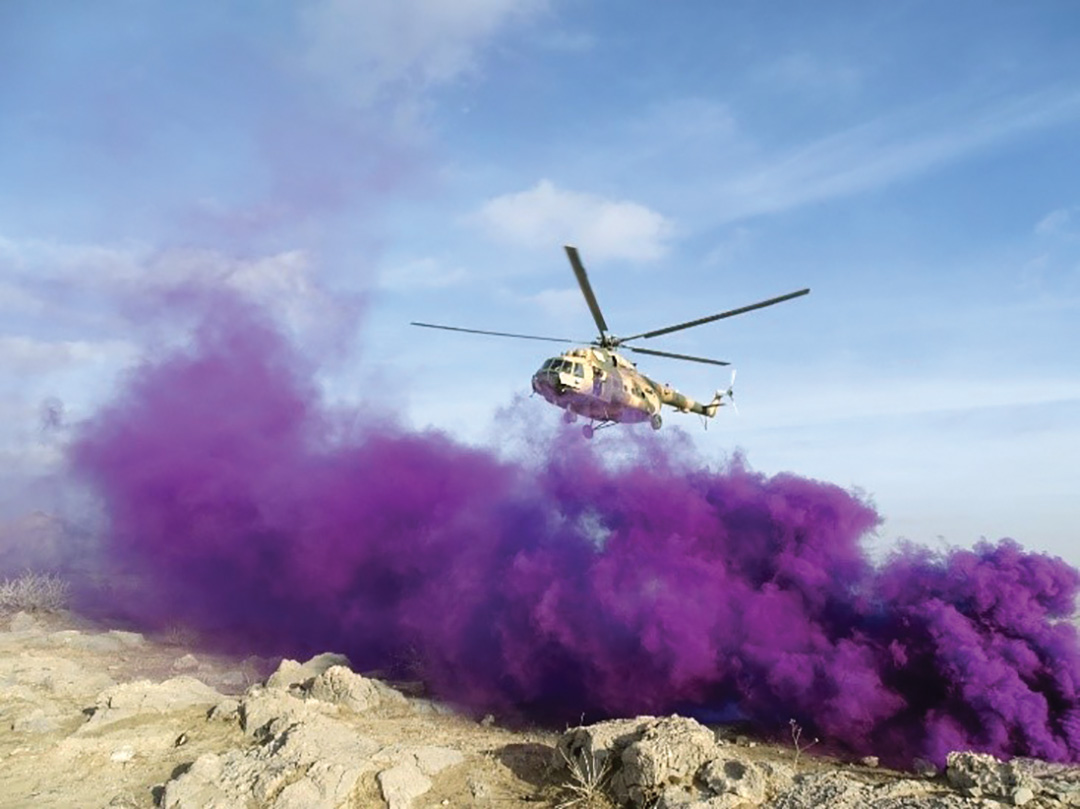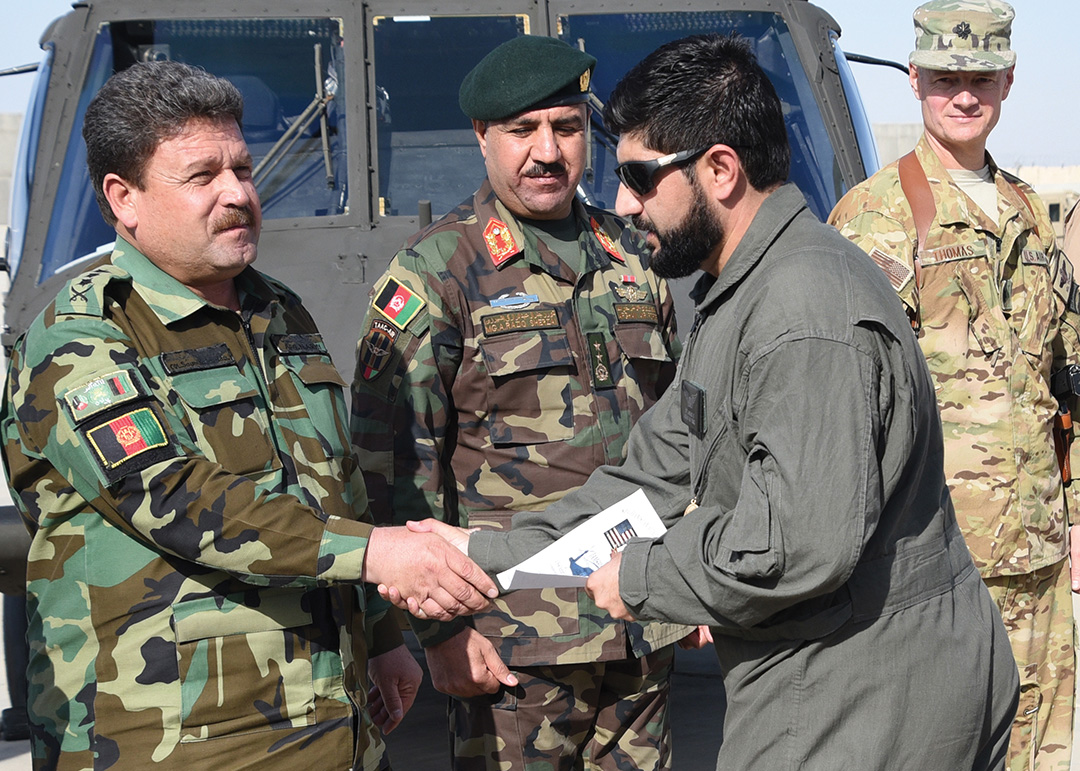Assault from the air
The Afghan Air Force boosts firepower and improves training in the fight against terrorists
UNIPATH STAFF
Bolstered by the arrival of modern aircraft and the deployment of trained aviators, the Afghan Air Force is demonstrating greater mobility and firepower to convey Soldiers and supplies to and from battlefields across the country.
Afghan leaders, together with partners from the multinational coalition, lauded the advancements of the Afghan Air Force in breaking a military stalemate against the Taliban and other terrorists occupying the country.
“I am happily announcing that today a new page is opening in Afghanistan Air Force life,” Maj. Gen. Abdul Raziq Sherzai, the Kandahar Air Wing commander, said in late November 2017 at the graduation of new pilots.
Using helicopters and airplanes — including deliveries of UH-60 Black Hawks to replace the country’s aging fleet of Russian helicopters — the Air Force is flying thousands of sorties against the Taliban.
Accomplishments include not just moving troops and material to the battlefield, but also successfully extricating and evacuating wounded Soldiers and destroying Taliban drug processing labs used to finance terrorism.

Resolute Support Commander U.S. Army Gen. John Nicholson, the U.S. military’s senior leader in Afghanistan, viewed the improvements in manpower and machinery as decisive in the struggle against violent extremism.
Air power is critically important because it allows Afghan troops to dominate the ground-based Taliban. Afghanistan is scheduled to acquire up to 150 Black Hawk helicopters through 2019.
“A tidal wave of Afghan air power is on the horizon,” Gen. Nicholson said. “The momentum has shifted, and it is irreversible.”
Six pilots completed training on the new Black Hawk helicopters in late 2017, enduring 16 weeks of training. These first pilots were experienced aviators who developed their talents flying Russian Mi-17s. Fourteen more pilots will travel to the United States for training in 2018 and another 21 in 2019.
The first Afghan Black Hawk crews took off on missions in May 2018, their activation timed to the arrival of new helicopters.
“Today I’m very excited that it is my graduation day,” Afghan Air Force Capt. Jamshid Rezaye said in November 2017. “I cannot express my feeling right now, because I get to serve the Afghan people.”
Once Afghan pilots graduate and become mission ready, all combat missions will be flown and led by Afghans. Coalition members are minimally involved in such combat missions.
“I congratulate my young and patriotic pilots for this success and completion of their course,” Gen. Sherzai said. “I’m expecting these young pilots to use these modern and new helicopters, fighting bravely and strongly against the enemy and against terrorists.”
Capabilities have grown in other units as well. The Special Mission Wing, Afghanistan’s special operations aviation element, graduated 15 trainees of its Green Platoon at the unit’s headquarters in Kabul on Nov. 25, 2017. Instruction occurred on PC-12 multipurpose planes and Mi-17 helicopters. Instructor pilots, two PC-12 student pilots, four Mi-17 helicopter pilots and other crew members completed training needed to serve in the Special Mission Wing.
“The graduates are entrusted with upholding the highest standards of professionalism of those who came before them and those who will follow in their footsteps in years to come,” said Lt. Gen. Mohammad Sharif Yaftali, Afghan Ministry of Defense chief of staff.

The Green Platoon course is a rigorous eight-week training program that focuses on field and classroom exercises, allowing fixed-wing and helicopter crews to interact in planning missions and devising tactics.
“The graduates are now part of an elite aviation unit,” said Richard Riley, assistant chief of mission for the U.S. Embassy in Kabul. “Their achievements are nothing short of remarkable for they now have a much greater purpose of providing and maintaining security for all of Afghanistan.”
Further training using C-130 aircraft has demonstrated the success of Afghans in resupply missions. In July 2017, Afghan Airmen and pilots and U.S. Air Force advisors made a round-trip C-130 flight from Hamid Karzai International Airport to Kandahar Airfield to drop off supplies and transport wounded Afghan National Defense and Security Force personnel to Kabul for further treatment.
“We fly several missions per week,” Lt. Col. James Torok, a C-130 advisor, said in late 2017. “At this point we’re pretty much in an assisting phase. Advising mainly comes into play when dealing with aircrew equipment and procurement. The Afghans are no longer coalition dependent on airlift missions.”
The entire C-130 airlift mission was planned, coordinated, controlled and executed by the Afghan Air Force. Afghan Air Force Maj. Khial M. Shinwari served as the aircraft commander of the mission.
“It was my dream to be an Air Force pilot,” the major said. “I come from a strong family lineage of military service; my brother and father served in the Afghan National Army, but I am the first member of my family the join the Air Force.”
U.S. Army Gen. Nicholson praised the more than 15,000 sorties flown by Afghan Airmen and the increasing modernization of the Air Force.
“Afghanistan is not only fighting for its own future,” Gen. Nicholson said in November 2017. “You are fighting for humanity’s future. We are with you in this fight, and we will stay with you.”


Comments are closed.